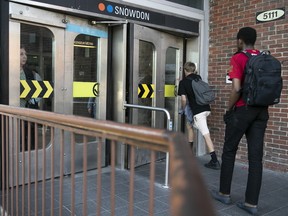Montreal transit agency calls on province to drastically increase money it has pledged for maintenance and to help restart stalled projects.

It was supposed to be a good news budget, but the STM’s directors warned Thursday of storm clouds on the horizon without a drastic increase in provincial funds.
For the first time since the pandemic, the STM adopted a balanced budget. As a result, the 2025 budget foresees no service reductions for bus and métro riders.
Years of sagging ridership have taken a toll on the transit agency’s financial situation. However, the STM now believes it will have recovered 88 per cent of its pre-pandemic métro and bus riders by the end of 2025.
STM board chairperson Éric Alan Caldwell called the budget “a rallying call” for all government levels, Montrealers, users and promoters of sustainable mobility.
“We have the best service in the country. We have 800,000 people transiting per day through the métro. That’s more than any other road or transit network in the country. We have to be responsible to make sure that what we have had in the last decades, we can have for the next decades, and for that, we need investment.”
Despite balancing the books, the amount of money invested in maintenance projects by the province has reached its lowest level since 2013, with just $2.4 billion pledged for a 10-year period, compared to the previous 10-year period of $3.6 billion.
Among the long-term projects in the current 10-year capital program are a modernization of the métro’s Green Line, which would add capacity for 37 per cent more riders on the trains. The $3.5-billion project will include the replacement of 40 MR-73 model trains with the newest Azur models and the addition of 20 trains to the line. A new maintenance workshop will be built at the Beaugrand garage and the Angrignon garage will be renovated. The métro’s control system will also be replaced.
But the budget also includes cost cuts. The STM has axed $16 million in recurrent costs for 2025, part of an overall plan to cut $100 million annually by 2028.
As part of those cost-cutting measures, the STM will reduce its overall fleet to 1,855 buses by next year from the current 1,992.
Léonard said the STM currently has 40 per cent more buses than the number of buses it deploys every day.
“Before the pandemic, we were missing buses, and we didn’t even have enough available to meet the daily needs,” Léonard said. “For us, this reserve has to consider projections for improving service. It has to consider the reliability of electric buses and mitigation measures that will be needed.”
The STM is willing to reduce its overall fleet, but Léonard wants to wait and see what ridership levels will be before making any cuts. She added it might be more realistic to have a 23-per-cent reserve, which is more in line with what Canadian transit operators target. The 20 per cent figure is a standard used more in the U.S.